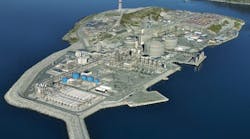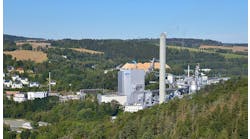In June, Editor in Chief Walt Boyes went to Norway for an ABB-sponsored press tour of the Statoil LNG complex on Melkøya Island in the fjord near Hammerfest. Hammerfest is one of the most northerly cities in the world, some 300 miles north of the Arctic Circle, and it argues with Honningsvåg over which is the northernmost city in Norway.
The press tour bus went through a long undersea tunnel to Melkøya Island, in the fjord off Hammerfest for briefings and a tour of the plant. The Melkøya LNG complex was built to serve the Snøhvit subsea well field complex. According to Statoil's website (http://tinyurl.com/bnnooz6): "Snøhvit is the first offshore development in the Barents Sea. Without surface installations, this project involves bringing natural gas to land for liquefaction and export from the first plant of its kind in Europe. It is also the world's northernmost liquefied natural gas facility. Snøhvit is the first major development on the Norwegian continental shelf with no surface installations.
Going for gas in the cold
Melkøya LNG Facility, Hammerfest, Norway is the northernmost LNG facility in the world.
"The seabed facilities are designed to be over-trawlable, so that neither they nor fishing equipment will suffer any damage from coming into contact. No fixed or floating units are positioned in the Barents Sea. Instead, the subsea production facilities stand on the seabed, in water depths of 250 m to 345 m. A total of 20 wells are due to produce gas from the Snøhvit, Askeladd and Albatross fields. This output is transported to land through a 143-kilometer pipeline."
The carbon dioxide injection pipeline Statoil's website mentions is in place so that the LNG plant can have a vastly reduced carbon footprint. Instead of releasing the CO2 as most facilities do, the Melkøya facility is designed to capture the carbon and re-inject it into the well field. This will cut the plant's carbon emissions by at least half compared to a normal LNG plant.
Statoil's vice president of production, Øivind Nilsen, talked about the plant and how it was constructed. The business end of the plant was actually built on a barge in Spain and towed to the site. In the meantime, a drydock had been built to fit the barge. The dock was filled, the barge floated in, and then the dock was emptied, leaving the plant permanently attached.
This necessitated the plant being built very compactly—perhaps too compactly, but it works. Nilsen noted that this gave Statoil enough real estate on the island to make two more plants of the same size. "We have lots of expansion room," he said.
Nilsen talked about what arctic gas means to Statoil in terms of new markets and revenues. He noted that if the planet continues to warm, the Northeast Passage is expected to open up all the way from Hammerfest to Vladivostok, Russia, and then to Japan and China. Shipping LNG that way will be faster and cheaper than going through the Suez or Panama Canals or around the Horn or Africa. Even though the prices for natural gas are low in the United States currently, Nilsen sees the U.S. as a fertile market in the future.
Per Erik Holsten, ABB's head of division for Process Automation in Norway, talked about the specific challenges of working in the Arctic and the Barents Sea. He noted that the area is ecologically fragile, home to spawning grounds for many food fishes, including cod, and needs to have especially high levels of environmental care taken with any undersea work, as well as with plants such as Melkøya. He described the design of the undersea facilities as "environmentally friendly."
Håvard Devold, vice president for oil and gas upstream market, talked about the innovative electrification systems that ABB and Statoil are pioneering, including high-voltage direct-current (HVDC) undersea lines to each of the subsea installations, so there is less energy loss than with AC transmission. Some of these lines are long, and doing HVDC is less expensive than AC would be.
Veli-Matti Reinikkala, head of process automation for ABB, gave his view of the opportunities for ABB in oil and gas production from now until 2015. He sees this industry vertical as providing significant growth for ABB globally, and he believes the Arctic finds will be core to ABB's business.
The tour group was suited up and did a full-scale tour of the plant. The plant includes field devices from many vendors, including Siemens and Endress+Hauser, but the control system is all ABB System 800xA. One of the interesting things was the large collection of fish swimming in the plant water intake, including flounder and other food fishes.
Borghild Lunde, ABB vice president of strategy and business development, talked about the challenges that subsea oil and gas exploration produce. The title of her talk was "Subsea: Longer, Deeper, Colder," and she discussed what the future holds for wells further from shore, deeper and colder than any drilled so far. These challenges are, of course, compounded with the need for environmental sustainability and a low carbon footprint.
Statoil, working with ABB, is doing some extremely innovative work in subsea exploration and drilling and in the extraction of natural gas. The HVDC and carbon dioxide return lines alone are nearly unique, and the completely underwater gas well installations are very forward-looking and environmentally friendly. With complete subsea installations, the chances of a blowout like Deepwater Horizon are vastly reduced.




